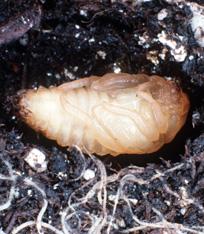

slightly smaller than the females. You are most likely to see the adults from late spring through midsummer.
During the feeding period, females intermittently leave plants, burrow about 3 inches into the ground—usually into turf—and lay a few eggs. This cycle is repeated until the female lays 40 to 60 eggs.
By midsummer, the eggs hatch, and the young grubs begin to feed. Each grub is about an inch long when fully grown and lies in a curled position. In late autumn, the grubs burrow 4 to 8 inches into the soil and remain inactive all winter. This insect spends about 10 months of the year in the ground in the larval stage.
In early spring, the grubs return to the turf and continue to feed on roots until late spring, when they change into pupae. In about 2 weeks, the pupae become adult beetles and emerge from the ground. This life cycle takes a year.
Homeowner Control
No quick fixes can rid homeowners of the Japanese beetle once it becomes established. However, scientists with USDA’s Agricultural Research Service and Animal and Plant Health Inspection Service (APHIS) have developed an integrated pest management (IPM) program for homeowners based
3
